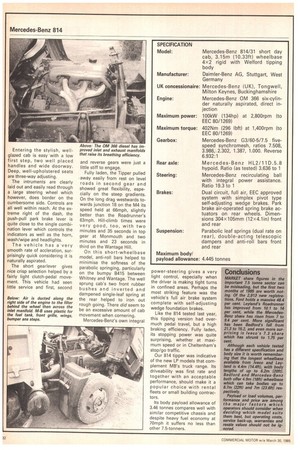Smooth, stylish performer
Page 35

Page 36

If you've noticed an error in this article please click here to report it so we can fix it.
WHEN Daimler-Benz finally replaced its ageing LP range last July it did so with a completely new family of light/middleweights. A new tilting cab and chassis, two new engines, full air brakes and power steering are among the new features giving the range a strong presence in the 7.5-tonne market.
At this weight there are two models, an 809 and 814, each with an entirely different driveline, and the more powerful 814 was our choice for this group test. As Daimler-Benz will not lend us a vehicle to engage in this type of comparison exercise, we hired one.
Four wheelbases are offered with each 7.5-tanner, ranging from 3.15 to 4.9m (124 to 193m). Our test vehicle, a short wheelbase 814/31 with a Welford tipper body conversion, is a typical self-drive hire vehicle. It had only 3,040km (1,900 miles) on the clock.
How did this vehicle, a tipper with a 5.6-litre OM 366 engine, fare around our demanding Welsh route? There were no major shocks and I was impressed by its smooth performance and ease of handling.
Fuel consumption proved to be fairly predictable considering that the driveline specification was similar to that of the longer 4.25m (167in) wheelbase 814/42 that we tested last October.
Driven at 70mph, the 814's engine revs rose to 2,350, taking the tacho needle way out of the green 1,600 to 2,200rpm economy sector. It was hardly surprising that with a fairly quick 102.6km/h (63.8mph) average speed between Membury and Aust services on the M4 its fuel consumption rose to 22.44 lit/100km (12.59mpg).
With the 3.636:1 final drive its maximum geared top speed should have been 107km/h (57mph), but a governor runout in excess of 10 per cent allowed it to achieve the maximum speed limit with some to spare.
Along A-roads and dual carriageways its fuel efficiency naturally improved, giving 17.32 lit/km (16.31mpg) and bringing the overall average up to 18.60 lit/100km (15.19mpg).
From these figures it becomes clear that to obtain the best fuel return would mean using the vehicle at speeds below 96km/h (60mph) and letting it lug where possible.
A local jobbing builder might be inclined to do just that, but for a spot-hire vehicle life is rough; it is either filling in for lorries under repair or being used on excess contract work.
In many cases these non-hgv trucks are used by non-understanding drivers who will never make the best use of the rev counter. Daimler-Benz has played its part, though, building a vehicle that feels and drives like the quality commercial that it is. Entering the stylish, wellglazed cab is easy with a low first step, two well placed handles and wide doorway. Deep, well-upholstered seats are three-way adjusting.
The intruments are clearly laid out and easily read through a large steering wheel which however, does border on the cumbersome side. Controls are all well within reach. At the extreme right of the dash, the push-pull park brake lever is quite close to the single combination lever which controls the indicators as well as the horn, wash/wipe and headlights.
The vehicle has a very smooth rate of accleration, surprisingly quick considering it is naturally aspirated.
The short gearlever gives nice crisp selection helped by a fairly light clutch-pedal movement. This vehicle had seen little service and first, second and reverse gears were just a little stiff to engage.
Fully laden, the Tipper pulled away easily from rest on level roads in second gear and showed great flexibility, especially on the steep gradients. On the long drag westwards towards junction 18 on the M4 its speed held at 66mph, slightly better than the Roadrunner's 63mph. Hill-climb times were very good, too, with two minutes and 35 seconds in top gear at Monmouth and two minutes and 23 seconds in third on the Wantage Hill.
On this short-wheelbase model, anti-roll bars helped to minimise the softness of the parabolic springing, particularly on the bumpy B415 between Whitney and Wantage. The well sprung cab's two front rubber bushes and inverted and dampened single-leaf spring at the rear helped to iron out rough going. There did seem to be an excessive amount of cab movement when cornering.
Mercedes-Benz's own integral power-steering gives a very light control, especially when the driver is making tight turns in confined areas. Perhaps the most striking feature was the vehicle's full air brake system complete with self-adjusting wedge foundation brakes.
Like the 814 tested last year, this tipping version had overmuch pedal travel, but a high braking efficiency. Fully laden, its stopping power was quite surprising, whether at maximum speed or in Cheltenham's stop/go traffic.
Our 814 tipper was indicative of the new LP models that complement MB's truck range. Its driveability was first rate and together with an acceptable performance, should make it a popular choice with rental fleets or small building contractors.
Its body payload allowance of 3.46 tonnes compares well with similar competitive chassis and despite heavy fuel economy at 70mph it suffers no less than other 7.5-tonners.
























































































































































